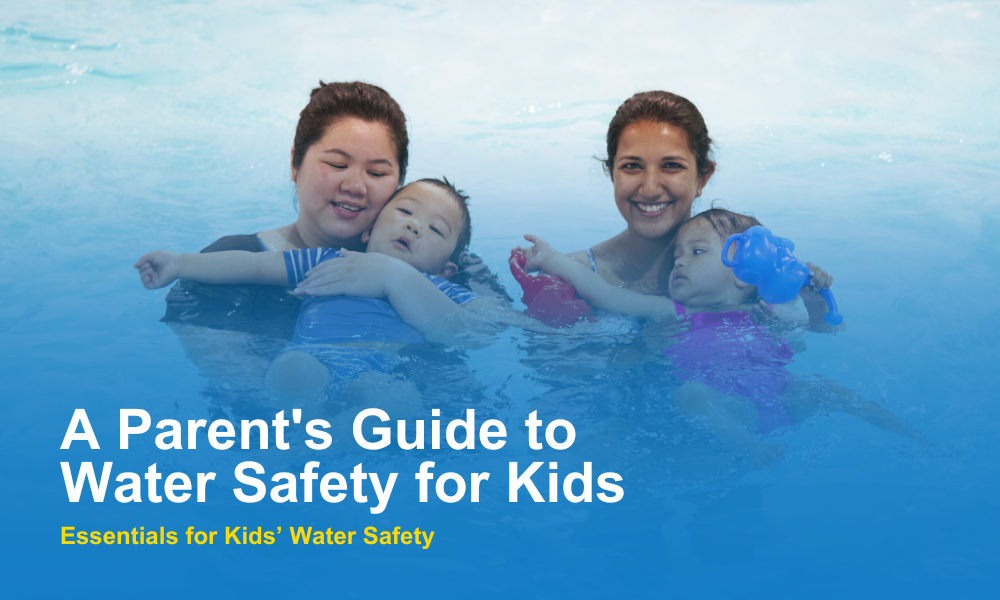Australia’s sparkling beaches, inviting pools, and endless sunshine scream fun! But for parents, that joy can be tinged with worry. Water safety for kids in pools is essential because this recreational activity is a large part of the Aussie way of life.
Why is Water Safety For Kids Essential?
The statistics around water-related injuries and fatalities for children in Australia are sobering. These accidents can happen in the blink of an eye, even in a familiar environment like a backyard pool. Drowning can occur silently, with a child going below the surface unnoticed for just seconds.
Water safety for kids in pools is essential because it equips your child with the knowledge and skills to navigate emergencies. It’s more than just a temporary safeguard. It also enables your child to safely and confidently play in pools.
What Skills Does Your Child Need to Save Themselves?

Forget fancy dives and competitive strokes – survival swim lessons should focus on core skills that could save your child’s life. Here at Shapland Swim Schools, we prioritise these essential techniques:
- Floating: This is the absolute foundation of water safety for kids. Staying afloat calmly buys precious time for your child to call for help or wait for assistance to arrive. Instead of relying on floaties, Shapland’s instructors teach kids valuable floating techniques that become second nature. These skills will keep them afloat with confidence, anytime, anywhere.
- Basic Skills: Imagine your child accidentally falling into the deep end. Basic skills like sculling or paddling will allow them to move themselves a short distance to safety. This could be the difference between reaching the pool’s edge or grabbing onto something to hold on to.
- Underwater Comfort: Many childhood pool scares involve going below the surface unexpectedly. A child who panics when their head is immersed can quickly lose control and struggle to resurface. We help children develop comfort being underwater, teaching them to control their breathing and calmly surface.
Beyond Floaties: Why Swim Aids Might Not Be A Lifesaver
Floaties and goggles are a common sight at pools, often seen as a safety measure for young children. However, while they may provide a temporary sense of security, swim aids can actually hinder a child’s ability to develop essential water survival skills.
The False Comfort of Floaties
Imagine this: a child has spent months splashing around with inflatable arm bands, feeling confident and supported. Then, one unexpected moment, they find themselves in deep water without their usual floatation aids. Panic sets in. The skills they haven’t practiced because of the crutch of the floaties become unavailable, potentially leading to a dangerous situation.
Swim aids create a false sense of security for both the child and the supervising adult. A child who relies on floaties may not develop the body awareness and basic swimming techniques necessary to navigate the water independently. Similarly, parents or guardians might feel overly confident due to the presence of floaties, potentially leading to a lapse in supervision.
Beyond Goggles: Building Confidence Without Reliance
Goggles, while helpful for children with sensitive eyes, can also pose a safety risk in the context of learning to swim. If a child who relies on goggles falls into the water unexpectedly and loses them, the unfamiliar feeling of water in their eyes can trigger panic. This can make it difficult for them to utilise the swimming skills they’ve learned.
By prioritising swim lessons and encouraging practice without aids, you gift your child with the confidence and skills they need to truly enjoy the water safely. While pool floaties and goggles may seem like a safe idea, remember, the most valuable “tool” for water safety is a strong foundation in swimming skills.
Safety Around Bodies of Water
Creating a safe environment around pools goes hand-in-hand with teaching water safety to kids. Here are some additional tips to keep in mind:
- Constant Supervision: This is the golden rule, especially for young children. Active supervision means putting away distractions like phones and focusing all your attention on your child when they’re near in and around pools, the bathtub, the beach and dams.
- Barriers: Install pool fences and self-closing gates to restrict unsupervised pool access. Remember, young children can be surprisingly resourceful climbers, so ensure the fence is secure and no objects nearby can be used to climb over it.
- Empty Portable Pools: Don’t underestimate the danger of even a tiny amount of water. Empty portable pools entirely after each use and store them securely out of reach of children.
How Shaplands Specifically Addresses Water Safety

We prioritise water safety through small classes, qualified instructors and unique pools designed for progressive skill development. Let’s take a closer look:
Enhancing Water Safety Through Education and Environment
At Shapland Swim Schools we believe a multi-pronged approach is essential for fostering water safety in children. Here’s how we go beyond traditional swim lessons:
- Employ instructors passionate about teaching children about water safety.
- Teach essential water survival skills.
- Hands-on pool practice with clear appropriate explanations.
- We prioritise small class sizes with a maximum of 3 students per session.
- Through personalised attention, we ensure each child receives the support and instruction they need thrive and keep themselves safe in and around water.
- We provide a quiet learning environment to maximise learning and reduce over stimulation.
- Our pools that are uniquely designed for teaching swim skills and safety.
The Advantage of a Purpose Built Pool
At Shapland, our pool design is purpose-built for safety and learning with 8-11 varying depths. Due to the unique design, children learn how their bodies react and change in the varying depths of water and changes in gravity at their own pace. Shallower depths are ideal for practising floating and basic propulsion, and deeper sections where children can gradually build confidence under close supervision. Your child can find a safe level to learn at and enable them to gain skills for ability and control. Along with suitable depths, the quiet learning environment increases feelings of comfort and safety for little learners and reduces distractibility so they can develop skills with confidence.
The Advantage of Semi-Private Classes
Small class sizes offer many benefits for water safety for kids. Here are some key advantages:
- Individualised Attention: With fewer students, instructors can devote more time to each child, addressing their specific needs and concerns. This personalised approach allows children to progress at their own pace and feel comfortable asking questions.
- Focus on Safety: In a smaller group, instructors can maintain constant vigilance, ensuring every child is safe and accounted for throughout the lesson. This heightened focus allows for immediate intervention if a child struggles or needs assistance.
- Building Confidence: A smaller group setting can be less intimidating for children who may be apprehensive about being in the pool. They have more opportunities to participate actively and receive positive reinforcement from the instructor, fostering a sense of accomplishment and boosting their confidence in the pool.
The Significance of Industry-Qualified and Experienced Teaching Staff
The qualifications and experience of your child’s swim instructor are paramount. Qualifications ensure teachers know how to best deliver safety training and swimming techniques to children and help them build confidence in the pool. At Shapland Swim Schools, we take pride in our team of dedicated professionals:
- Industry-Qualified: Our instructors are certified by recognised industry bodies, which include AUST SWIM/ASCTA qualified and they’re Blue Card holders. These certifications ensure they possess the expertise to teach safety skills and that they have the highest safety standards and best practices.
- CPR and First-Aid Certified: In addition to being skilled educators, our instructors are certified in CPR and first aid. This training equips them to handle emergencies confidently and provides parents peace of mind.
- Passionate and Experienced: Our instructors are passionate about swimming and nurturing a love for the water in children. Their experience allows them to connect with children personally, making learning fun and engaging. They understand children’s unique challenges and fears and possess the patience and understanding to guide them through those anxieties.
By combining these elements – a focus on core survival skills, small class sizes, experienced instructors, and a unique pool environment – Shapland Swim Schools creates a safe and nurturing space for children to learn valuable water safety skills and build confidence. Find out more by contacting us and booking your child’s first lesson.
Key Takeaways:
- Always supervise children in, on and around a pool.
- Have your children learn swimming, safety and lifesaving skills from a young age.
- Fence pools.
- Aids like floaties are best avoided.
- Ensure your swim centre has qualified staff.

